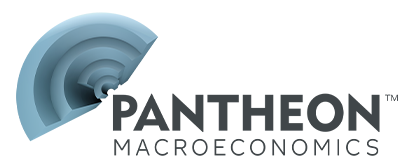Pantheon Publications
Below is a list of our Publications for the last 5 months. If you are looking for reports older than 6 months please email info@pantheonmacro.com, or contact your account rep.
Please use the filters on the right to search for a specific date or topic.
Daily Monitor
- We expect the initial April payrolls estimate to show a fall of 30K month-to-month.
- LFS unemployment will likely tick up to 4.5% in March, and LFS employment should gain 166K.
- Pay growth remains strong; we expect private ex-bonus AWE to rise 0.3% month-to-month.
- We expect GDP growth of 0.5% in Q1, although big questions hang over net trade and inventories.
- GDP likely will broadly stagnate over the rest of this year, as tariffs hit real incomes and investment.
- Shortages of products made in China are unlikely to emerge in stores until July.
- February’s IGAE rebound brought short-term relief but failed to alter Mexico’s waning growth trajectory.
- External trade tensions and domestic political uncertainty continue to weigh heavily on capex.
- Government growth forecasts are disconnected from prevailing conditions, with recession risk high.
- Thai exports continued to soar in Q1, on the back of US tariff front-loading, which leapt in March…
- …But their boost to GDP growth should be counter-balanced markedly by much more destocking…
- …While service exports likely will impose their first big drag post-Covid, given falling Chinese tourists.
- Industrial profitability improved further in Q1, on the back of strong manufacturing production.
- China’s industrial output was bolstered by stimulus demand and tariff front-loading activity.
- External uncertainty does not bode well for producers’ profit outlook, as overcapacity issues are worsening.
- Market expectations for the ECB’s deposit rate to stay below 2.0% next year are a sitting duck.
- Bunds are fairly valued at 2.5%; fiscal policy poses upside risk, but trade wars pull in the other direction.
- EURUSD is overshooting our models; EZ equities are set to struggle for a while longer.
- The insolvency rate remains low, and well below recession levels.
- Payroll-tax hikes have stopped the insolvency rate falling, and leading indicators have ticked up a little.
- We expect corporate distress to stay low, even as the trade war weighs on GDP growth.
- Small banks have run down their Treasury holdings since 2023, especially long bonds.
- The biggest risk for small banks is further tariff escalation, which would hit CRE valuations and lift yields.
- A tariff-driven bounce in business investment in Q1 will give way to a slump in Q2 and Q3.
- Mexico’s surprise inflation rebound in early April reflects temporary shocks…
- …Primarily the lagged effect of MXN depreciation, rather than a fundamental shift in the inflation trend.
- Retail sales point to a broader slowdown in domestic demand, despite a better-than-expected Q1.
- Taiwan’s March retail sales rose by 0.4% year-over-year, though our seasonal adjustment erases this…
- …We see worrying signs in motor vehicle, textiles, and fuel sales, the three largest components.
- This all points to a weak Q1 private consumption print, ahead of next Wednesday’s GDP release.
- Most near-real-time consumers’ spending indicators suggest it is holding up well in April.
- The trade war also hasn’t hit job postings, while Google searches for ‘unemployment’ are down.
- Leading indicators on production, meanwhile, reflect greater activity, boosted by tariff front-running.
- A swathe of data on the labour market indicates that the job market is cooling, not cratering.
- But the balance of risks has shifted to a faster shake-out after President Trump’s tariffs.
- We expect the unemployment rate to rise to 5.1% in 2026 as the trade war dampens GDP growth.
- April’s S&P Global PMI points to GDP growth of 1½% in Q2; the regional Fed surveys are only a bit weaker.
- Tariffs are lifting manufacturers’ costs, but service sector disinflation is ongoing; the Fed can ease soon.
- Post-tariff uncertainty and the upturn in mortgage rates will add to the headwinds facing housing.
- Brazil — Uncertainty and fiscal risks resurfacing
- Mexico — Reforms and trade noise persist
- Colombia — Reform gamble deepens risks
- Bank Indonesia stayed on hold this month, but—rightly—downgraded its 2025 growth forecasts…
- …Consumption is still struggling to increase more meaningfully, and confidence is starting to wobble.
- India’s trade deficit ballooned unexpectedly in March, but underlying import demand is flailing.
- Soft April PMIs signal downside risk to our Q2 GDP call, but we still think tariff front-running will help.
- Demand for services is retreating, confirming that trade uncertainty is weighing on domestic demand.
- Manufacturing is holding the fort for now, with new orders recovering thanks to tariff front-running.
- Mr. Trump’s tariffs and the resulting uncertainty have led the UK PMI to tank to its lowest since late 2022.
- Rising price pressures and the PMI’s overreaction to uncertainty mean the MPC will retain some caution.
- But downside growth risks mean we expect back-to-back, precautionary, rate cuts in May and June.
- Fear of a severe economic and market hit will dissuade President Trump from firing Chair Powell...
- ...But the president’s tariffs show he is willing to throw caution to the wind on economic policy.
- The S&P Global PMI likely will indicate higher goods inflation, but services inflation remaining in check.
- Colombia’s economic rebound continues, thanks to falling inflation and resilient services…
- …But other sector performances remain uneven and fragile, and financial volatility poses a growing risk.
- The US–China trade war is a threat to key exports and investment; domestic policy options are narrowing.
- China’s Q1 GDP growth relied heavily on net exports, highlighting the need to boost domestic demand.
- But new residential-property sales have waned this year, notably in oversupplied markets.
- Policymakers will prioritise job creation by supporting consumer services and construction.
